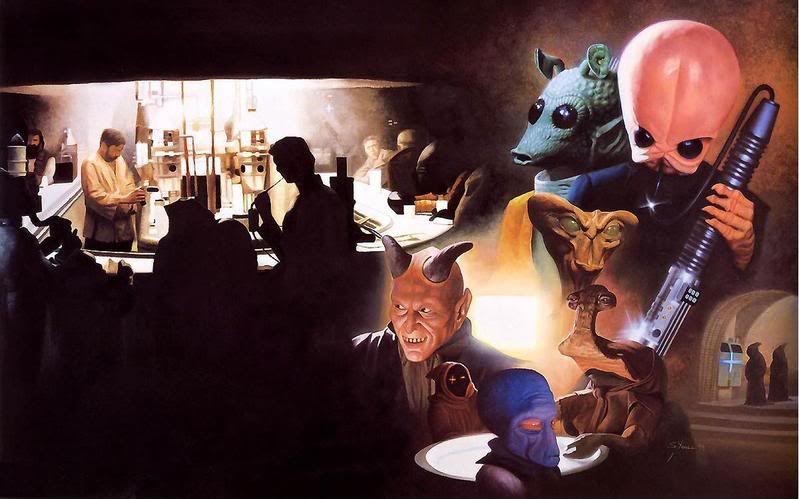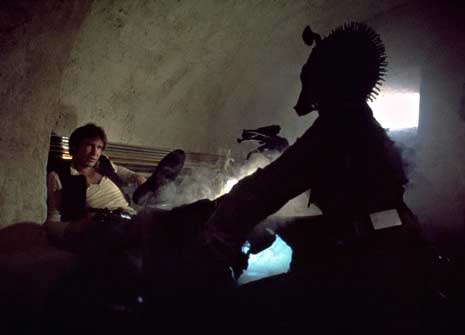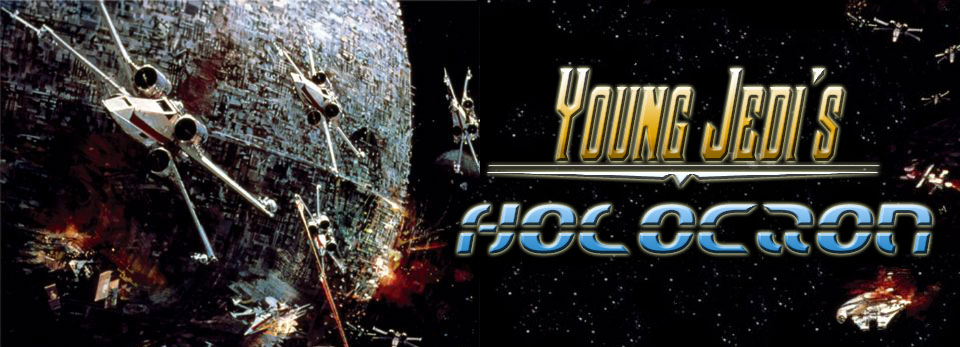
Luke’s family, Uncle Owen and Aunt Beru, make their living as simple farmers – their homestead is situated in the middle of nowhere, where they grow crops using moisture vaporators. Quite like the pioneers of the West who have to struggle against the American wilderness to survive. And if they have to worry about unfriendly Indians, Owen Lars has to deal with the Sand People (aka Tusken Raiders – a tribe native to Tatooine unlike the colonist men. The animals they ride are called Banthas and to some extent resemble the buffaloes from the prairies). Some scenes later Obi-Wan and Luke are observing the destroyed sandcrawler of the Jawas wondering who wiped them out. Obi-Wan notices immediately: “These tracks are side by side. Sandpeople always ride single file to hide their numbers.” This is a trick known from many adventure stories, usually used by the Indians.

And while we are on this subject, allow me to make a little flashback to “Episode II: Attack of the Clones” where George Lucas revisits the Sand People theme. When Anakin goes back Tatooine he finds out that Shi, his mother had been kidnapped by the Sand People. Cliegg Lars, Smi’s husband, remembers: “It was just before dawn. They came out of nowhere. A hunting party of Tusken Raiders. Your mother had gone out early, like she always did, to pick mushrooms that grow on the vaporators. From the tracks, she was about halfway home when they took her. Those Tuskens walk like men, but they're vicious, mindless monsters.” If we interpret these words in the context of the western, here you can see clearly the white woman, kidnapped by “red savages” – the clash of two incompatible cultures and even traces of racism. The scene when Anakin is approaching the Tusken village is a direct nod to John Ford’s “The Searchers” and the moment when John Wayne is observing the Comanche camp. Later on, seeking revenge for his mother’s death Anakin slaughters the whole Tusken village, “and not just the men... but the women, and the children too”. In his anger he says: “They're like animals! And I slaughtered them like animals! I hate them!”
Back to “Episode IV: A New Hope”. For Luke the adventure begins when R2-D2, one of the newly bought droids, runs away. As a matter of fact the whole story of the Star Wars saga is seen through the eyes of R2’s old friend the protocol droid C-3PO (human-cyborg relations, fluent in more than 6 million forms of communication). In some western movies we have similar characters like journalists and writers who follow the hero on his quest, describing his adventures in articles or sensational novels. Most of these characters are used as a comic relief, constantly complaining of the discomforts and dangers they have to put up with, just like 3PO. And by the end of the movies they are also turned into somehow reluctant heroes. And let us underline the similarity between buying a droid from the Jawas and bargaining for a horse on the stock market. Or that the Jawas wandering through the desert with their sandcrawler resemble the wagons of the traveling merchants, circus artists or theatre troupes of the old west.

And something curious I haven’t noticed, until I read it on the internet: When Luke got rescued by Obi-Wan and R2-D2 was found the framing of the shots through the opening of the cave where the little droid is hiding, directly matches the framing of the screen shots of John Ford’s “The Searchers” when Ethan Edwards' reunion with his niece, Debbie.
Immediately after he realizes that his family might be in grave danger Luke rushes back home, only to find the homestead burned down and his aunt and uncle killed by the Imperial strormtroopers. Ranch burned and family massacred triggers the action of many western movies, the character who has nothing to lose sets on a quest for justice and/or vengeance. Quite often the villain in these movies is some sort of a crooked authority like the land barons, Union/Confederate soldiers or some corrupt railroad company – the western equivalent of the technocratic Galactic Empire. A good example is Jessie James, portraied in the movies as a Robin Hood type of guy, a sympathetic outlaw, who leads his gang (the Rebel Alliance in the case of Star Wars) trying to bring down the railroads.

Luke joins Obi-Wan on a mission to save Princess Leia. The starting point of their journey is the Mos Eisley spaceport – a wreched hive of scum and villainy, which equals the town on the frontier from the western movies (including visually - the architecture draws heavily on the Mexican style). Its dusty steets are crawling with shady characters – gamblers, scoundrels, space pirates and smuglers.

One of them is Han Solo, captain of the Millennium Falcon (I’m sure you’ve heard of it, it’s the ship that made the Kessel Run in less than twelve parsecs). Solo is the typical gunslinger of the western movies. Both his appearance and attitude match the wild west stereotype, turning him into a space cowboy. You can find him in the cantina (or the saloon), flirting with some damsels or settling up some old business. And when the smooth talk can’t do the trick he won’t hesitate to try with the good old blaster. If the things get rough Han can always count on his co-pilot and best friend, Chewbacca. Chewie is one of the most lovable Star Wars characters and in a western you can easily imagine him as the Indian sidekick – absolutely loyal, he speaks a language only Han can fully understand, he’s almost naked, and in a fight he’s using a bowcaster instead of a common blaster, not to mention that his very name sounds Indian (does Chingachgook ring any bells?).

If you go further into the Expanded Universe (all those countless adventures except the two trilogies, like novels, comic books and video games, which develop the history of the Star Wars Universe) you’ll see that there’s quite a history behind Hand and Chewie’s friendship. Back in the days before Episode IV Han was a Lieutenant in the Imperial. Chewbacca fights for freedom as his people, the wookies (who by the way live separated in clans on the beautiful tree-filled planet Kashyyyk – a world not corrupted by technology and civilization, much like the Indians and the American wilderness before being colonized) are being chased by slave traders and sold to the Empire. After opposing his commander and disobbeying direct orders Han saves Chewbacca from being whipped to death and they find themselves outlaws, with bounty on their heads. If this is not a space western I don’t know what is (saving an Indian and deserting from General Custer’s army).


But let’s get back to the movie. The cantina scenes are pure western “translated” into sci-fi. "Most of the best freighter pilots can be found here. Only watch your step. This place can be a little rough." – Obi-Wan warns Luke. Chalmun's Cantina, also known as the Mos Eisley Cantina is filled with all sorts of bizarre creatures and dubious elements. Instead of a jangly piano we have the Cantina band (a direct reference to the jazz and swing clubs of the 30s and the 40s). The typical grumpy bullies looking for a fight is also present – Ponda Baba lost his arm by Obi-Wan’s lightsaber after attacking Luke. And just like in the wild west saloon when someone gets shot – there’s a moment of silence, everybody takes a peek at the scene and then they all go back to their drinks and the music starts again as if nothing happened.

But another, even more interesting violent encounter is about to be seen. “Going somewhere, Solo?” - the Rodian bounty hunter Greedo points his blaster at Han. Seems like not only the Empire is after the captain of the Millennium Falcon. Greedo is sent by the notorious crime lord Jabba the Hutt. Han smuggled glitterstim (a kind of drug) for the gangster, but he was boarded by an Imperial patrol and had to dump his load of spice and his employer wasn’t too happy about it. We could easily imagine Han smuggling alcohol for Capone, but sincew we’re into westerns now – there was a lot of smuggling during the Civil War too (let alone that the conflict between the Galactic Empire and the Rebe Alliance is known as The Galactic Civil War). Greedo gets rough and eventually ends up fried, shot by Han. In the original release of the film, Greedo did not shoot at Han at all. In the 1997 re-release of the film, Greedo gets a badly-aimed shot at Solo before Solo kills him. George Lucas has said that this change is to enhance Solo's overall heroism. This was a controversial decision and in the 2004 version the two shots are almost simultaneous, with Greedo shooting first. I’ll stick with the original idea, it’s not “politically correct”, but it’s just so spaghetti-western, anti-hero, Clint Eastwood style:
Greedo (in Huttese): “You may only lose your spaceship!”
Han: "Over my dead body!"
Greedo: “That's the idea. I've been looking forward to this for a long time.”
Han: "Yes, I'll bet you have!"
And Han shoots him under the table! It’s totally bad-ass!

The scene at Docking Bay 94, shot in 1976 but never shown in the original theatrical release is remastered and added in the Special Edition (1997). We see Jabba, acompanied by a threatening bunch of bounty hunters. One of them is the fan-favourite Boba Fett. Just a few seconds of screen time are enough to earn him a cult status. In “The Empire Strikes Back” he works for Darth Vader and manages to track down the Falcon on its way to Cloud City. “What if he doesn’t survive? He’s worth a lot to me” – asks Boba Fett when Han Solo is frozen in carbonite. Eventually Fett gets payd by both the Sith Lord and Jabba the Hutt after delivering Solo. “I see why they call you the best bounty hunter in the Galaxy” – says Darth Vader. Boba Fett is established as a classical anti-hero, quite similar to well-know charaters from the spaghetti westerns like Sartana, Blondie or Sabata. His face is always hidden behind his helmet and the same enigmatic and threatening approach is used in westerns, where the character’s face is hidden in the shadow of his hat. Another feature of his outlook is a short cape he wears, very similar to the famous Clint Eastood poncho from Sergio Leone’s “Dollar Trilogy”. The name Boba Fett is never mentioned in “A New Hope” and “The Empire Strikes Back”, so up to “Return o the Jedi” he remains a Man with No Name.


More depth is added to the character of Boba Fett in his adventures from the Expanded Universe, where we see that he even survived the Sarlac Pit from “Return of the Jedi”. The origins of the character are revealed in “Episode II: Attack of the Clones” – Boba is in fact an unaltered, perfect clone of the Mandalorian bounty hunter Jango Fett, who raises him as a son. The name Jango is a direct homage to the Italian western movie “Django” from 1966, directed by Sergio Corbucci and starring Franco Nero as Django. (Offtopic: due to the loose copyright laws back in those days the name of the popular characters were used in countless unofficial sequels or even given to characters who had nothing to do with the originals, and so cashed on the popularity of the original. The most notable among the Django unofficial sequels is “Viva Django” aka “Django, prepare a cofin” from 1968, where Django is portrayed by Terence Hill. An official sequel was released in 1987 – “Django Strikes Again”, with Franco Nero returning as the main character and Nello Rossati directing. Curiously enough in the Star Wars Universe Jango Fett is the one they clone to create the Clone Army. Thousands of Jango Fett copies are created, just like Django is rumoured to have spawned more than 100 unofficial sequels, though only 31 have been counted). Jango Fett is even swinging his pistols the same as the cowboys in the wild west!

In terms of structure and key plot elements Star Wars follows a classical pattern, used by many westerns, but traced back to ancient legends and fairy tales – one of the things that make Star Wars a modern myth. One classic motif is going into the Dragon’s den and rescuing the Princess. And while in Star Wars the firebreathing monster is replaced by the ominous space station, The Death Star, in western movies women are being abducted by indians as seen in John Ford’s “The Searchers” or Ron Howard’s “The Missing”.
Another classic motif is the transformation of Han Solo from a smuggler into a hero of the Rebellion at the end of the movie. George Lucas describes the character as "a loner who realizes the importance of being part of a group and helping for the common good." While watching Star Wars we get this feeling (or at least I do) that there’s something from his past that troubles him. Feels like his cocky attitude and self-preserving way of life is some sort of a defence mechanism, a result of some events before “A New Hope”. If we go back into the Expanded Universe we can trace what shaped his character up to the moment we meet him on screen. But I’ve already mentioned about the origin of his friendship with Chewbacca, and that for some time he was serving the Empire. It’s a theme in many western movies - characters haunted by guilt and their memories from the Civil War, withdrawn from the world until they find a way to redeem themselves. Though Han Solo’s character in particular is not so dark and somehow closer to the the outlaws with hearts of gold established by Bud Spencer and Terence Hill (most notable are their Trinity and Bambino from Enzo Barboni’s cult comedy-western classics “They Call Me Trinity” and “Trinity Is Still My Name”). They are the type of guys who start doing something for profit but in the process start helping defenceless people and get into troubles only to find themselves broke and back where they started, but now as morally right reluctant heroes.
Seems like there are a lot of similarities between some stories that take place once upon a time in the west and a long time ago in a galaxy far, far away ;)


















3 comments:
I'd have to say THE most complex. What other series has six installments, out of order with plot lines continuing through all of them. Disregarding pointlessly drawn out horror series of course but even most of those are relatively unrelated to each other.
Lgoan Lamech
www.eloquentbooks.com/LingeringPoets.html
I love your comparisons between Star Wars and the old Westerns. You obviously spent a lot of time and effort on this and did a lot of research.
That being said, I think the similarities between the two are more a factor of Lucas's open ended writting than him creating a space western.
Many of the comparisons you made could be made with other genres. You could easily write an article calling Star Wars a space fairy tale, except that's already been done.
You could easily call this a space pirate movie. Is Han Solo a cowboy or is he a pirate? Is he both? A significant portion of each movie takes place on board ship. In episode III and episode VI fleets of slow moving frigates fly within point blank range of each other and exchange broad sides. That sounds more like ancient sailing ships than future space fleets.
The truth is that Star Wars is all those genres and more. It is written in such a way that we can bring whatever genre we like with us when we watch it. If we are looking for cowboys we will see them. If we are looking for a fairy tale we will see that. If we want action, romance, humor, adventure, we will see that too. It's all in there.
I think its the writer's job to allow his audience to bring what they want to the story and not force his own preconceptions on people.
William R Kurfman
Lost in Antiquity
http://www.eloquentbooks.com/LostInAntiquity.html
Thank you for your comments :)
I agree with you both. This article was an assignment for a course I enrolled at the Uni, "American Culture and Cinema", and the tast was to compare a movie which is not a (typical) western to the western genre in general. But with Star Wars you can compate it to literally almost any genre that is out there, not only western, pirate stories, action-adventure, omance, fairy tale... For example Yoda can be compared to the old teacher/master from Asian Kung-fu movies :) As you said - it's all in there! And that's what makes Star Wars a modern myth!
Post a Comment